5 important considerations when developing your cooling tower Risk Management Plan
With the recent changes to cooling tower regulations throughout NSW, consultants and environmental health officers (EHOs) will be undertaking inspections of all cooling tower systems to ensure facility owners are complying with the new regulations. This means all cooling tower owners must have a Risk Management Plan in place for each of their towers.
To assist you in preparing your RMP, we’ve compiled the following list of important factors to consider when choosing your RMP consultant.
1. Choose an RMP consultant that will work with you
When selecting a water management provider and consultant to develop your Cooling Tower Risk Management Plan, it’s important to choose one that can work to your budget and timeline.
Your RMP consultant makes recommendations for improving your cooling towers, and you will be audited on the basis of those recommendations. Failure to implement them will mean a failed audit.
You don’t want to be forced into implementing recommendations that are beyond what you can afford or do before your audit arrives.
Choose a provider that can work with you and your business’s budget.
2. Prioritise elimination of the main Legionella risks
You can drastically minimise the risk of Legionella growth in your cooling tower system by:
- Having your cooling tower components professionally checked, and;
- Implementing automated dosing controls to improve the health of your water.
Legionnaires’ outbreaks can also be prevented through minimising the transmission of water droplets to people. This is done by:
- Minimising drift (upgrade drift eliminators to compliance with AS 4180.1), and;
- Minimising the number of people in proximity to the cooling tower (this can be difficult because droplets can travel up to 500m).
3. Get your house in order
Ensure you’re compliant with the regulations by tidying up the area surrounding your cooling tower and getting your paperwork in order.
EHOs and consultants will be focussed on your paperwork, and a missing report will mean a failed audit. The best solution is digital as it is always up to date and it can’t go missing.
HydroChem has a digital reporting solution to ensure you meet compliance. For more information, visit Clarity.
4. Choose a provider that has a recognised history of high performance
The first question any health inspector will ask is “who is your water treatment provider”.
If you answer with a provider they know of having failed audits in the past, you can guarantee your towers will be subjected to a more rigorous audit at every step of the process.
Start off on the right foot by selecting a provider that is recognised for its high quality service and considered a leader in the industry. Watch the health officer breathe a sigh of relief. We’re not bragging when we say we’ve seen health officer’s relax when they hear the name HydroChem.
5. Ensure safe access
As part of their inspections, EHOs will be focussing on safe access to your cooling towers.
All walkways and handrails must be designed to meet the relevant requirements of AS/NZS 1657:2013.
This means access to the location of the cooling tower. For example, if it’s on a roof, how do you access the roof? What safety measures (walkways, handrails, scaffolds) are in place to prevent falls from a height, and what condition are those preventions in?
Safe access also refers to access to the cooling tower components needing to be serviced by your mechanical contractor and water treatment provider, including:
- Basin, fill, drift eliminators
- Valves and drain
- Safe removal of access hatches and panels
EHOs take safety precautions very seriously, and treat breaches to compliance as strictly as any other breach. Be sure at all times access to your cooling towers is safe at all times for anyone needing access.
Need more advice?
If you have any questions regarding these five important factors when developing your Cooling Tower Risk Management Plan, contact HydroChem today and we can help make sure your RMP passes the audit.



[…] by proper operation, installation and maintenance of the cooling towers and through NSW’s legionella compliance with certain rules and […]